1lumen selects and reviews products personally. We may earn affiliate commissions through our links, which help support our testing.
Haikelite HT90 review
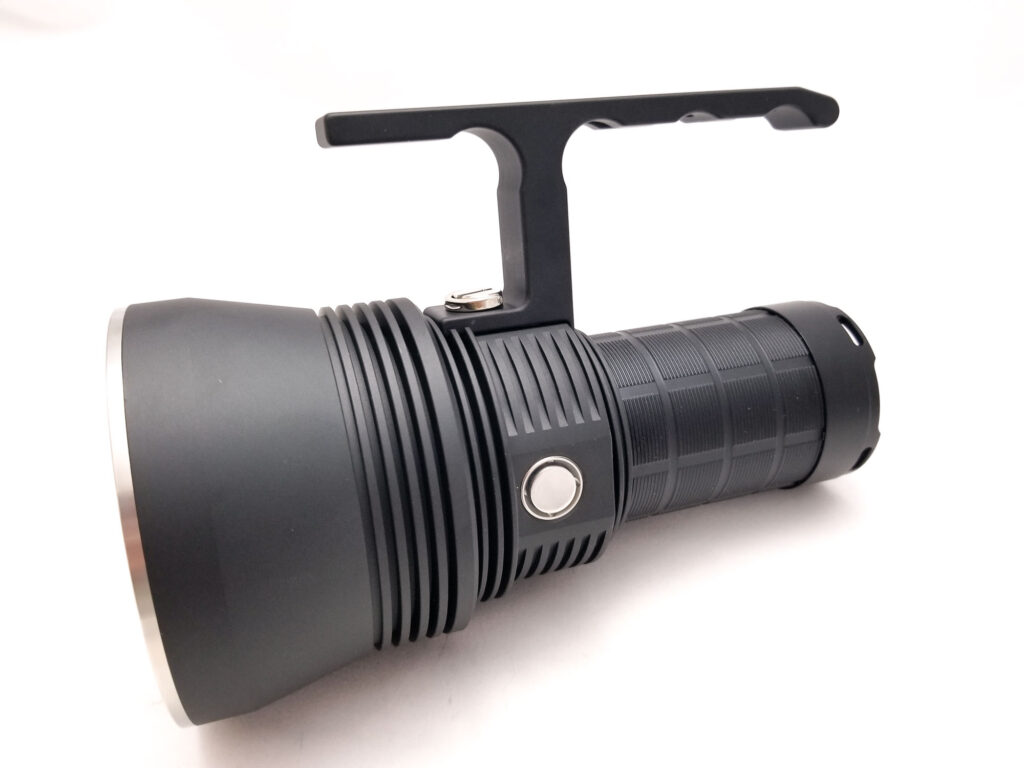
Haikelite HT90 specifications
| Brand & Model | Haikelite HT90 |
|---|---|
| Flashlight category | long-range searchlight / lumen monster |
| LED | 4*G90 |
| Max. output | 20,000 Lumens |
| Max. beam distance | 1600 meters |
| Max. beam intensity | 650,000 cd |
| Battery config. | 3*21700 |
| Onboard charging | USB-C |
| Modes | 5 |
| Blinkies | N/A |
| Waterproof | IPX6 |
| Review publication date | October 2022 |
Introduction:
It’s no secret that if you want a cheap (in a good way), high output flashlight, you fire up your web browser and head to places like Nealsgadgets, Aliexpress, Banggood, or for the Chinese speaking world, TaoBao. There you can find one of the quieter brands who specialize in producing great quantities of photons. I’m of course talking about Haikelite. Like Amutorch and Nightwatch, Haikelite produces simplistic, rugged designs and ergonomics, simple UIs (or Anduril if that’s your thing), multiple battery and LED options, all at really affordable prices.
However, the real reason you buy a Haikelite is the numbers: Big numbers for Lumens and throw. In the early days exploring the flashlight nexxus, Ifondly remember pouring over ads for the MT09R Buffalo, MT07 Devourer, MT03, and HK04. You’d be hard-pressed to find a Haikelite with under 5000 Lumens. I’ve never reviewed a Haikelite product until now. Nealsgadgets graciously sent me a couple of lights to test on, including a new Haikelite, the HT90.
This popped up on TaoBao a few months back as an alternative to the Haikelite HK90 (which Marco reviewed). That light featured 3 Luminus SBT90.2 LEDs (and cost almost $400). The HT90 however, makes do with 4 G90 LEDs in a 95 mm head behind a FET driver and 3, 21700 batteries. It promises 20,000 Lumens and 650 Kcd. Pretty impressive specs. Can the nearly $150 cheaper HT90 usurp the HK90? Let’s see.
Package quality.
I don’t expect nice packaging from budget Chinese flashlight manufacturers. Most of the time I get a box, (or not) with a flashlight and some bits inside. That’s it, and I’m fine with that. However, Haikelite packages their lights in decent packaging that gets the job done. It’s a plain white box with a polite slogan and Haikelite logos. Inside the light is nicely packed in foam with a plastic film on the lens. Here’s what you get:
- Haikelite HT90 flashlight
- 3 Molicel P42A 4200 mAh 21700 button top batteries (Optional)(loaded in the light)
- Spare o-rings
- USB type C charging cable (not pictured)
- USB type C to type C high output charging cable
- Manual
The light doesn’t come with batteries, but you can add them when ordering the light for an extra fee. It’s worth it, so just do it. You’ll need 3 identical, matched 21700s of the same brand, age, capacity, and discharge capabilities to get the most out of the light. Overall, this is a bit more than I was expecting and if you add batteries, everything you need to get going. I like how they included two USB type C cables: The type C to C comes in handy for the bidirectional charging (power bank) feature, and I’m glad to see that because a lot of manufacturers (like with the Wuben A1) cheap out here and don’t include one. The sample light had the all-too-familiar piece of hastily torn off cardstock in between the batteries and the driver to break the connection.

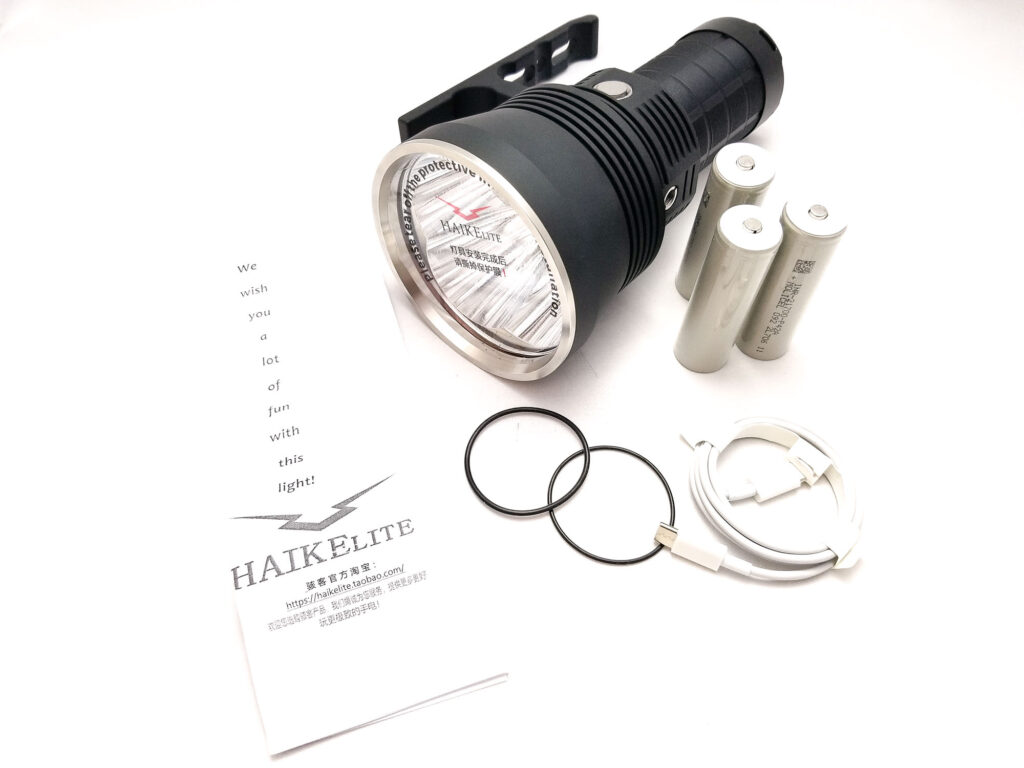
Flashlight in use
The HT90 occupies a pretty special corner of the use-case continuum and excels at casting large amounts of light long distances. This is good for surveying, inspecting, searching or chasing off critters (2-legged and 4-legged). It does include a detachable handle to help with toting it around, which is necessary (and keeps your hands away from the hot bits during extended use). This is a hybrid soda or soup cap style light, with a short battery tube with a wide, flat base and a huge head. The battery tube is pretty fat, and really was a handful even with my big hands. The tube has the same vertical reeding as the HK29 for grip, and combined with the grippy finish, I had no trouble hanging onto it.
Tail standing is not an issue either, and it won’t roll away if the handle is attached. The tailcap has 4 mounting points positioned at 12, 3, 6, and 9 o’clock for attaching a lanyard or other retention solution. The openings are wide, and I was able to pass ⅛” paracord through them.
The handle is aluminum, lightweight, and pretty basic. It’s secured to the head with a ¼-20 UNC flat head screw that has a swiveling bail that a lanyard or strap could be attached to for shoulder carry. I tried it with the shoulder harness from the Fenix LR80R and it worked perfectly. There are two mounting points for the handle or a tripod shoe, and each is threaded for ⅜-16 UNC and has a ¼-20 UNC threaded insert the unscrews with a dime or ⅜” flat head screwdriver. There’s one at 12 o’clock and one at 6 o’clock. This is great because you could attach the HT90 to a tripod with the larger or smaller threaded mounts without removing the handle. You might run into fitment issues though. The tripod shoe on my tripod was too big to fit against the side of the head.
About 30 degrees down from the handle attachment point is the large e-switch. It’s set in an aluminum or stainless bezel, has a nice shiny flat metal cover, and has aux RGB LEDs around a translucent bezel for battery and charging state. It’s pretty big, and sticks out enough to easily find by feel. The aux LEDs turn blue and stay on during operation, but do not light up on standby. The action is typical e-switch: a bit soft in the clicks, but still easy to manipulate and has good enough feedback. Like other cheaper lights of this type, you cannot operate the switch when using the handle. You need two hands. I wished some of the cheaper brands would do what Acebeam and Manker and Wuben have done for their big lights and add switch buttons to the carry handle, but I get it…we’re on a budget here folks.
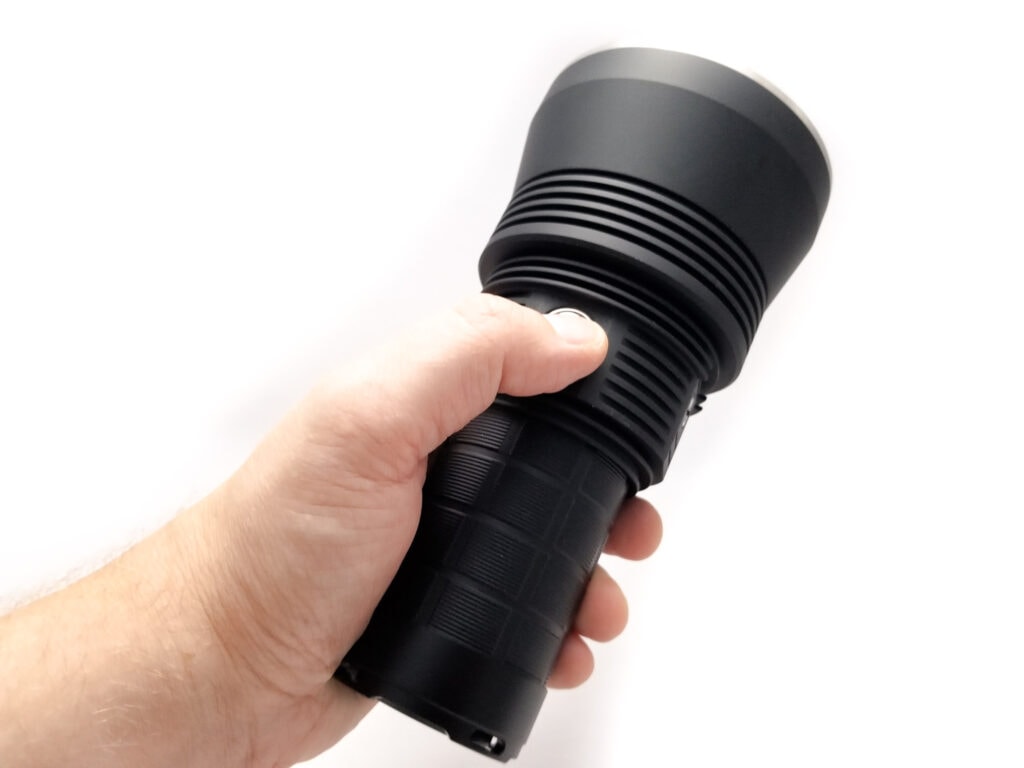
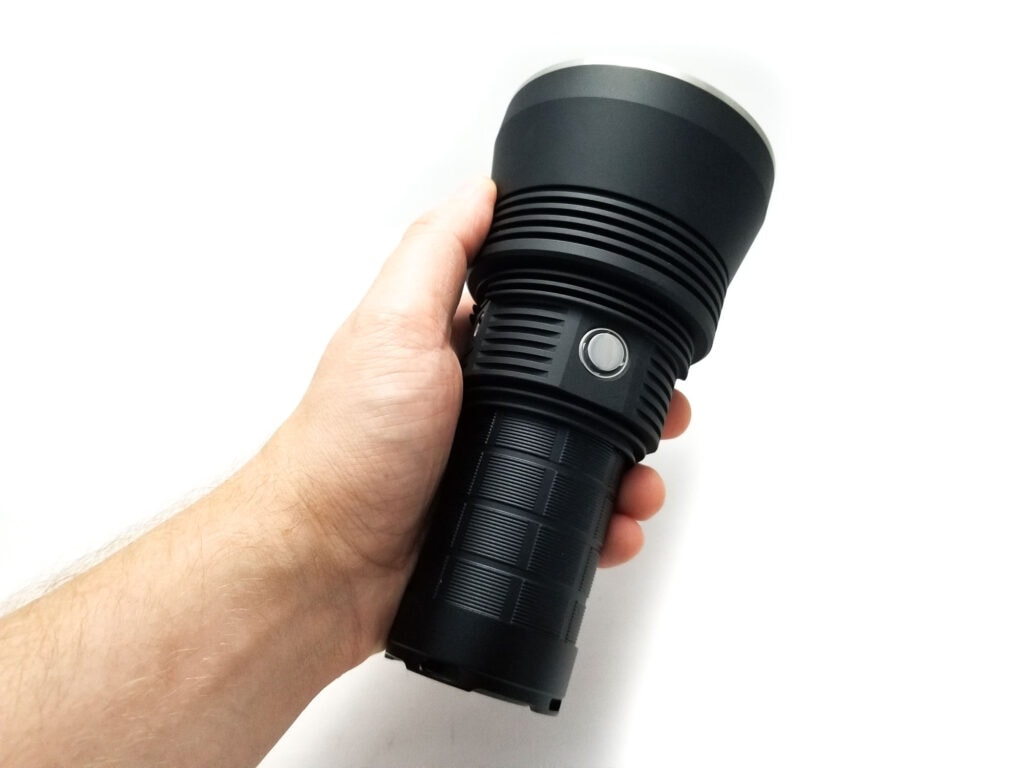
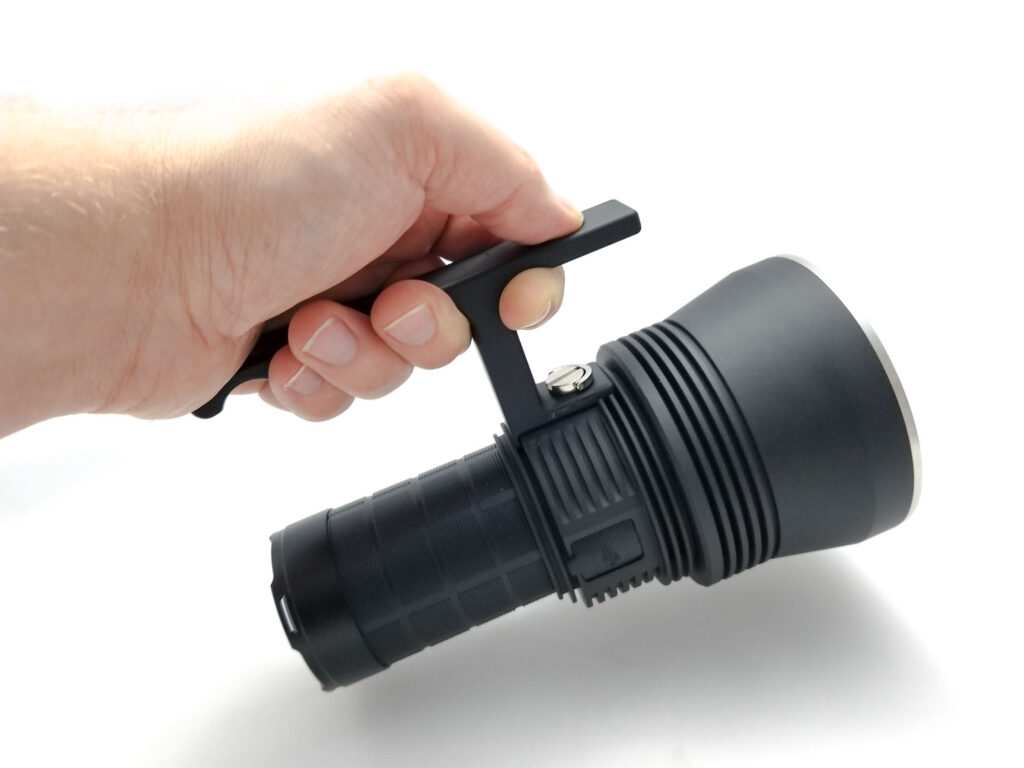
Build Quality, and Warranty
Haikelite makes a pretty decent product and they’re usually no-frills, no compromise designs of perfectly adequate quality at low prices. That said, the HT90 (depending on where you get it) sells for about $220 USD. That’s a fantastic deal considering the HK90 with 3 SBT90.2s sells for $350 or more. The light is milled from 6063 aluminum instead of 6061 and that’s a good thing because 6063 offers increased thermal conductivity and improved electrical properties (important for flashlights). It takes a better surface finish when machined, and is more corrosion resistant than 6061.
The machining is tidy and defect-free. Sharp edges have been knocked down as well, and there’s lots of heat sinking fins all over the head (it needs it). For the finish, it’s advertised as type III HA, and it’s a really nice, chalkboard-y matte black anodizing. It’s nicely done and my sample didn’t have any anomalies, and adds a lot of grippiness.
I like the overall fit and finish is appropriate for the price point. The issue with these finishes though is that it would get damaged or pick up scratches or abrasion more readily than a shinier finish. The light can be partially disassembled, but do it at your own risk. The bezel unscrews by hand, and that’s as far as I dared to go. The reflector is secured to the LED shelf by a central screw, and the driver seems glued in. The threads at the tube front and rear are square cut and pretty smooth and had plenty of lube.
The charge port cover is a nice rubber unit, but I don’t think it created that great of a seal. With a single o-ring sealing the front and rear of the tube, an o-ring at the bezel and the lens, and Haikelite ascribes an IPX6 rating. The light can be disassembled somewhat, but I’d only recommend it for adventurous or experienced modders since there’s a lot going on under the driver cavity.
The driver side has a brass contact ring, and peeking into the battery tube you’ll find high current phosphor bronze or copper alloy springs for the battery negative. They’re non-magnetic and pretty thick so they should handle high current demands. Unscrewing the rear cap of the battery tube reveals the tail spring PCB held on by nice brass screws. For the warranty, none is implied, and you’re at the mercy of whoever you bought the light from. However, if you bought it from Neal, he is pretty good about making things right if your Haikelite HT90 has an issue.
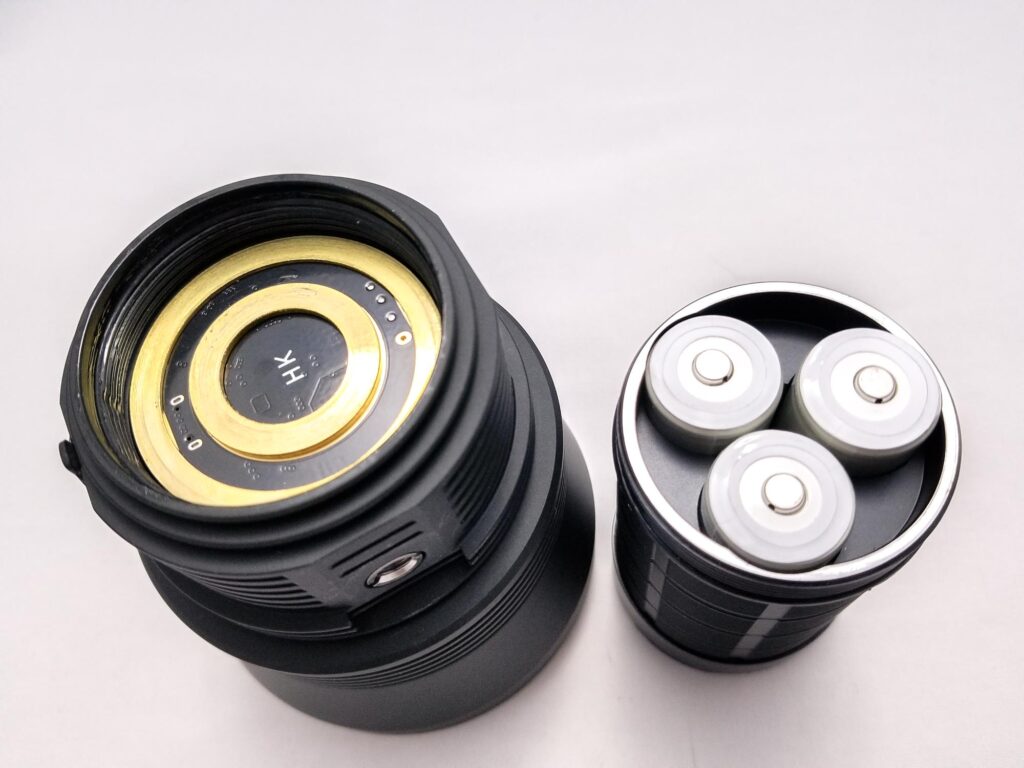
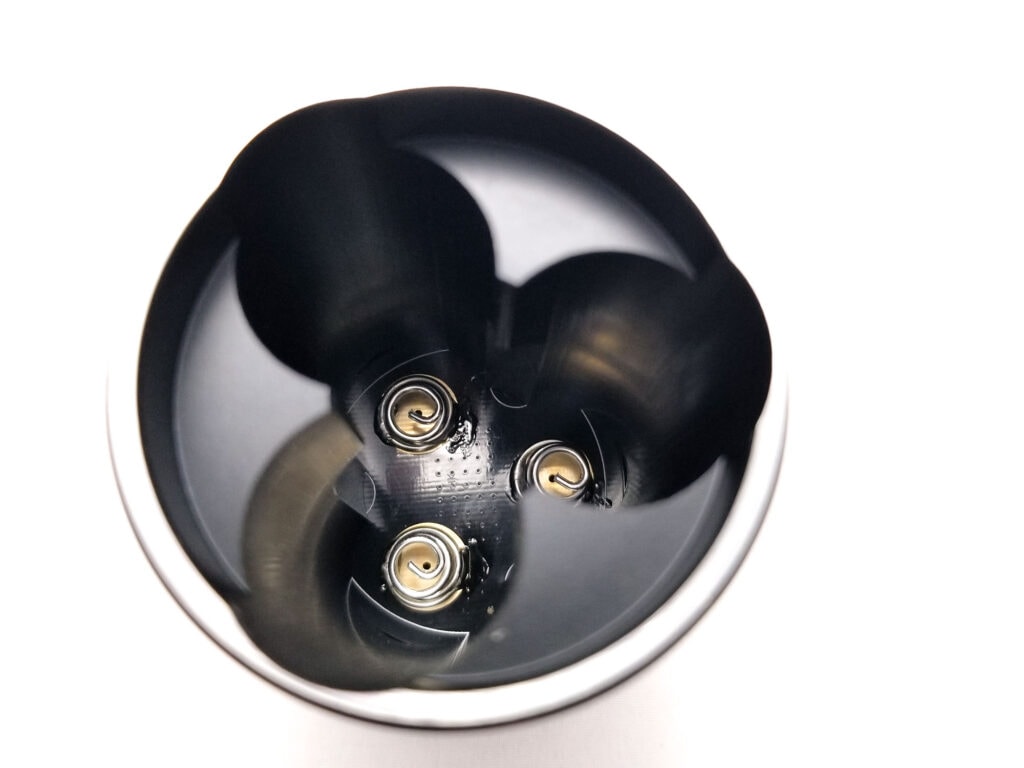
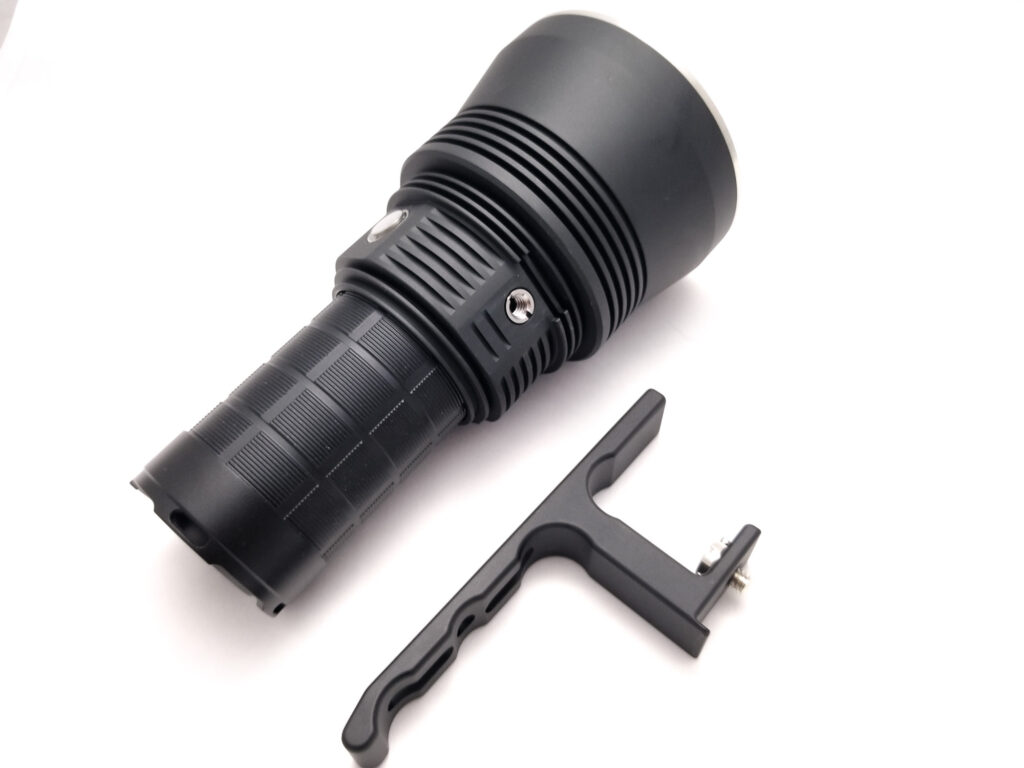
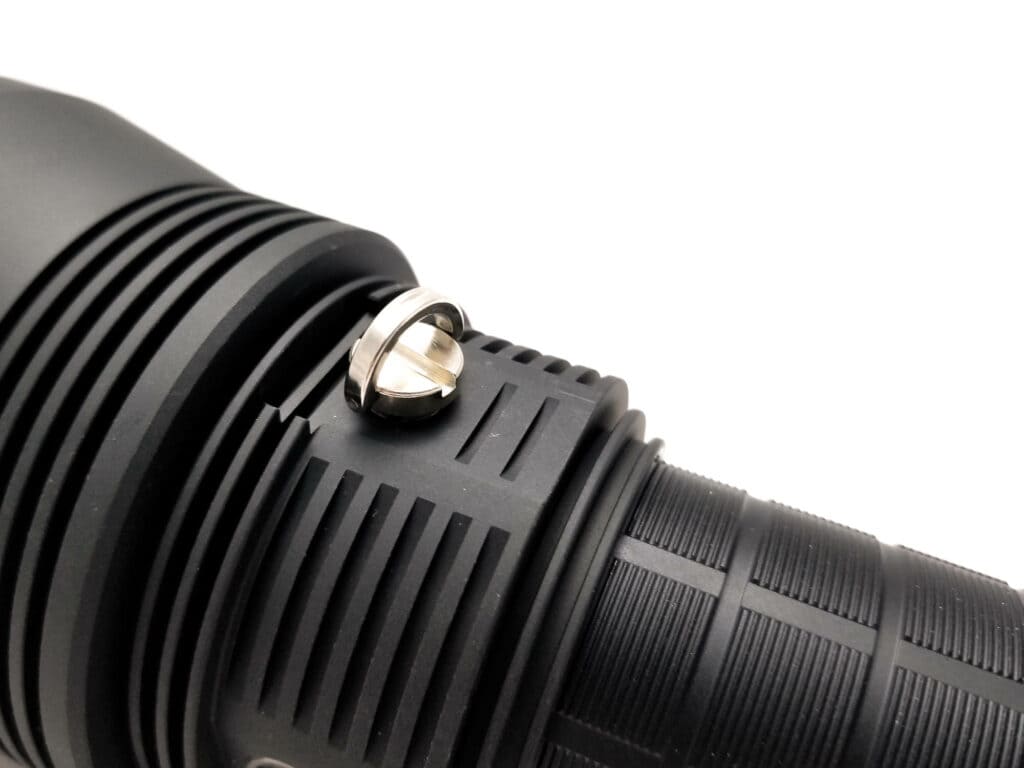
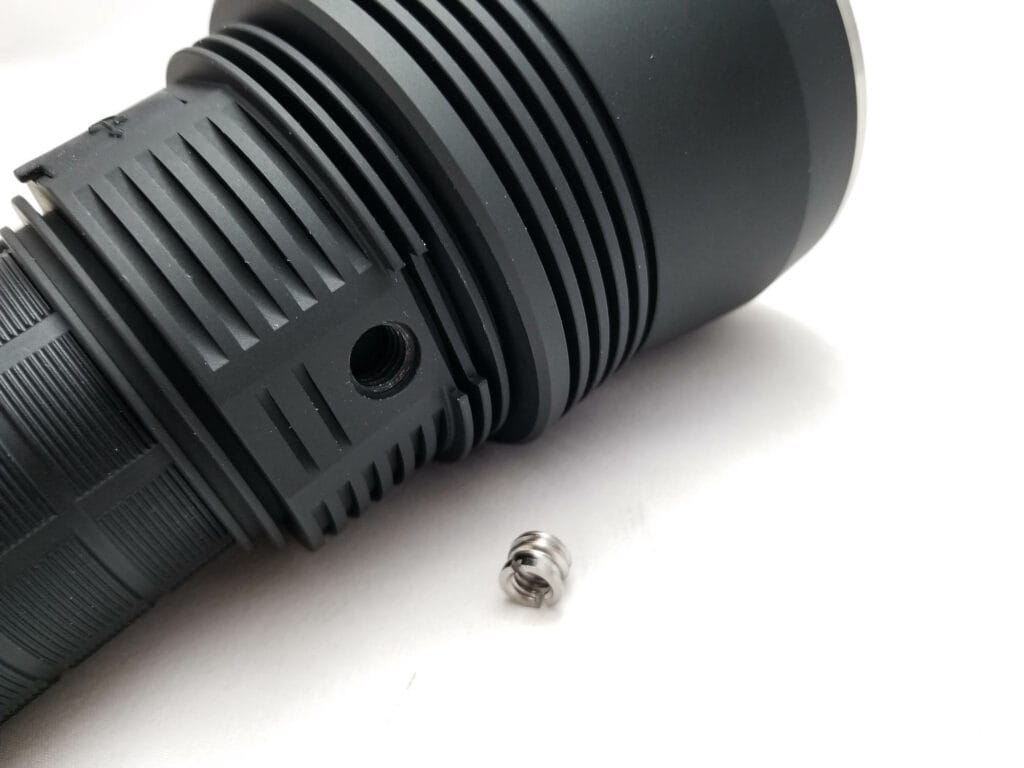
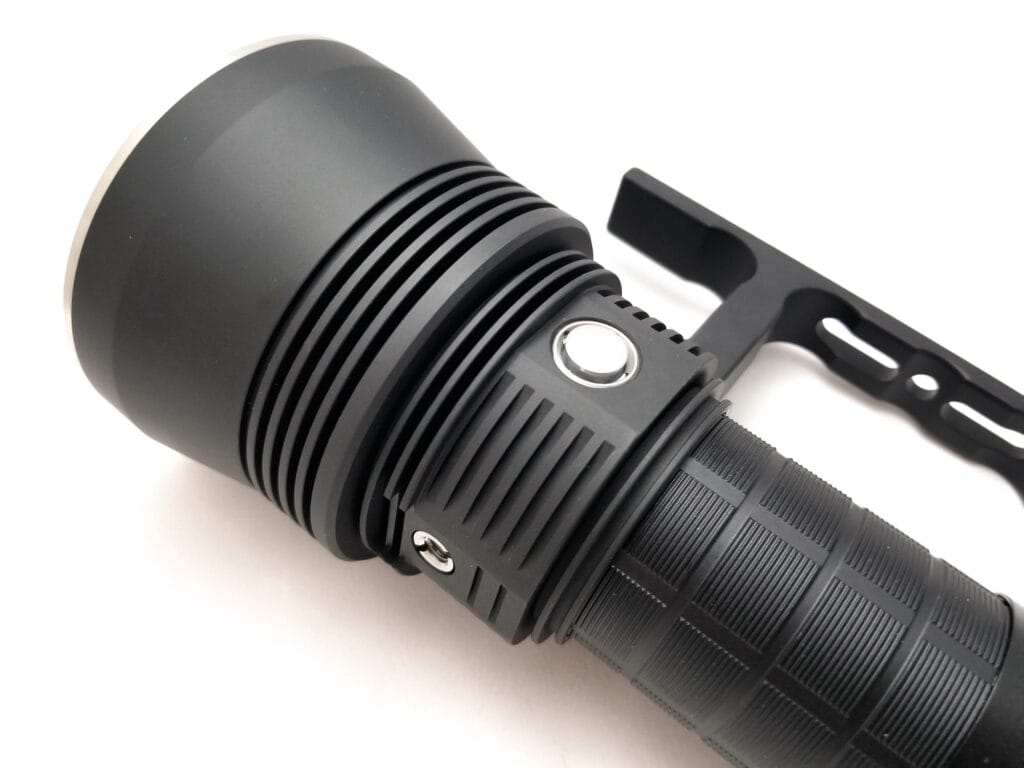
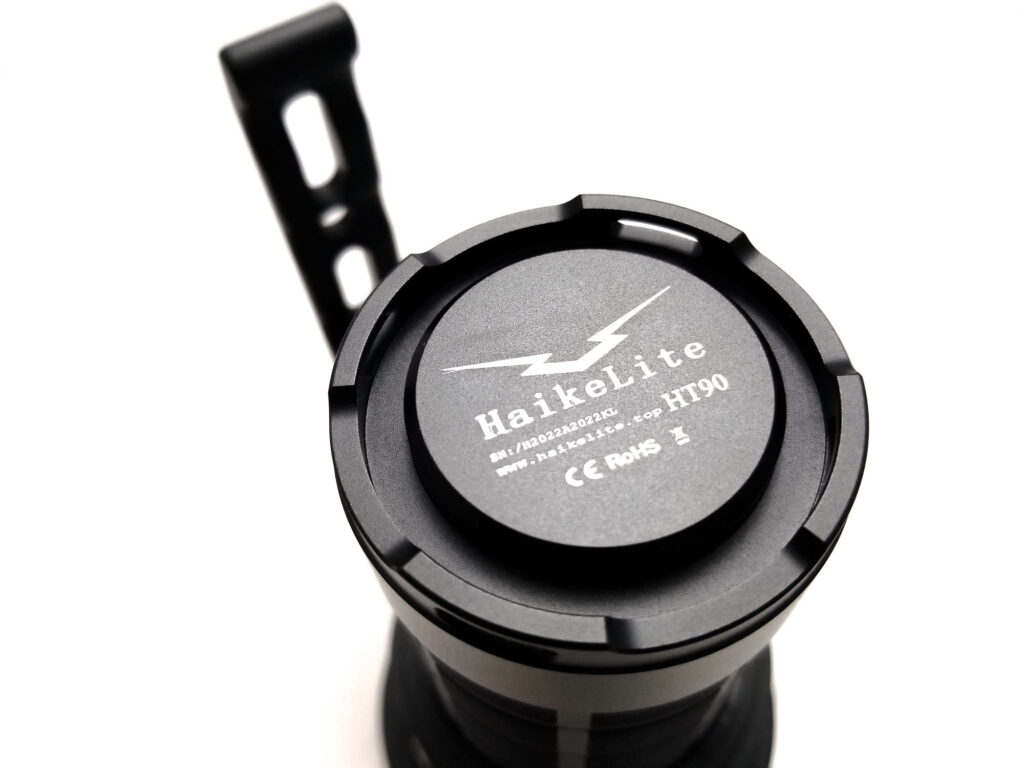
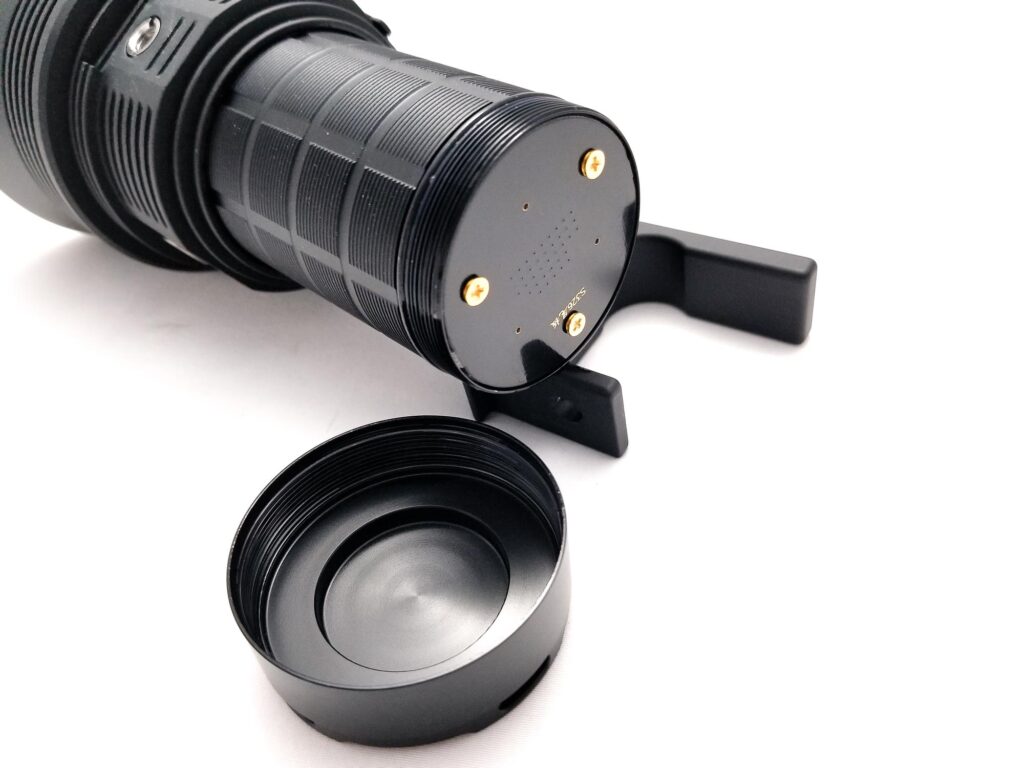
LED, Lens, Bezel, Beam, and Reflector
The Haiktelite HT90 employs 4 LEDs, and while other high output, long-throw lights of this type (Haikelite K90, Lumintop GT94, Wuben A1) use the Luminus SBT90.2, that’s an expensive LED. So, to keep the price down, Haikelite called up the SBT90.2’s Chinese cousin, the other, high output, high intensity LED, the G90. Also known as the GT9090 elsewhere, at the end of the day, it’s basically a Chinese clone of the 90.2, and there really isn’t any other alternatives. Visually it’s similar to the Luminus product, with some differences.
Although specs for this LED are nonexistent, both have 24 bonding wires (12 for the anode and cathode) connecting the monolithic LES to the substrate, both sit on an 11mm x 11mm footprint, and both are 3 volt LEDs. In addition, from Gabriel’s tests of the GT9090 in the NlightD T90, it achieves 90% of the SBT90.2s candela and output spec. The reflector is a quad SMO unit with the G90 LEDs sitting at the bottom in a black centering gasket, all topped off with a big piece of dual-AR coated mineral glass. The stainless bezel is crenelated and extends about 6 mm above the lens to protect it from drops. Unlike the SBT90.2 which comes in between 5500 and 5700K, the G90 is CW only, but of an unspecified tint.
The Opple Lightmaster Pro has the tint pegged at 6866K with CRI (Ra) of 69.4 with the light positioned 3 meters from the sensor in High mode. The duv is -0.0002, which is more blue than green this time. Turbo bumps the tint to 7259K and CRI Ra 70.8. Duv shifts to -0.0022. Overall, not bad for a CW LED with unknown binning, and I suspect the green AR coating on the lens helps out here. The beam? About what I expected, a tight, surprisingly small hotspot with lots and lots of bright spill. Artifacts are plentiful, but you can’t escape that with a quad reflector, and to be honest, they aren’t all that obtrusive. There’s amazing amounts of throw and lots of side illumination. The beam is a bit green at lower output, but it’s only really visible indoors on white walls.
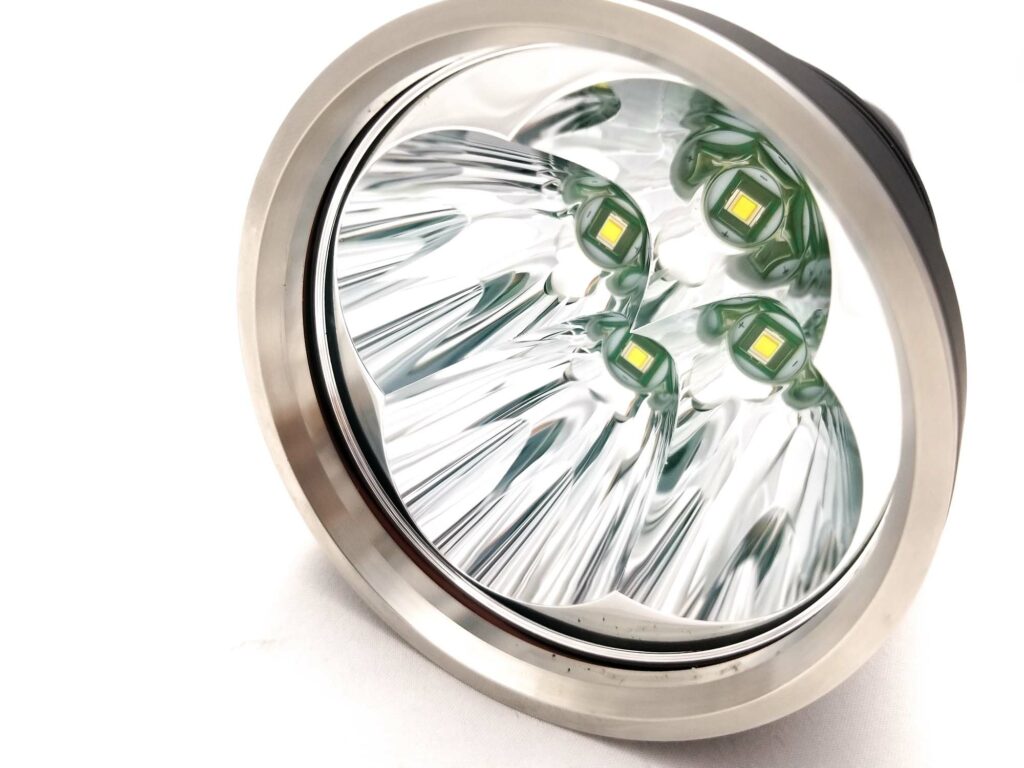

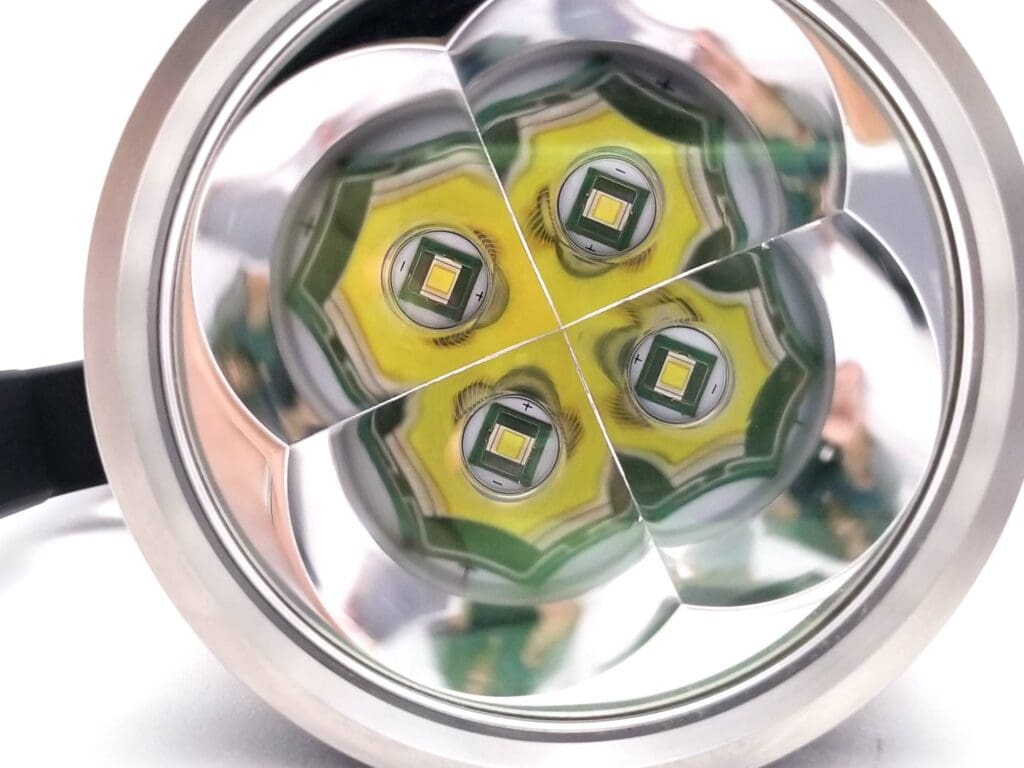
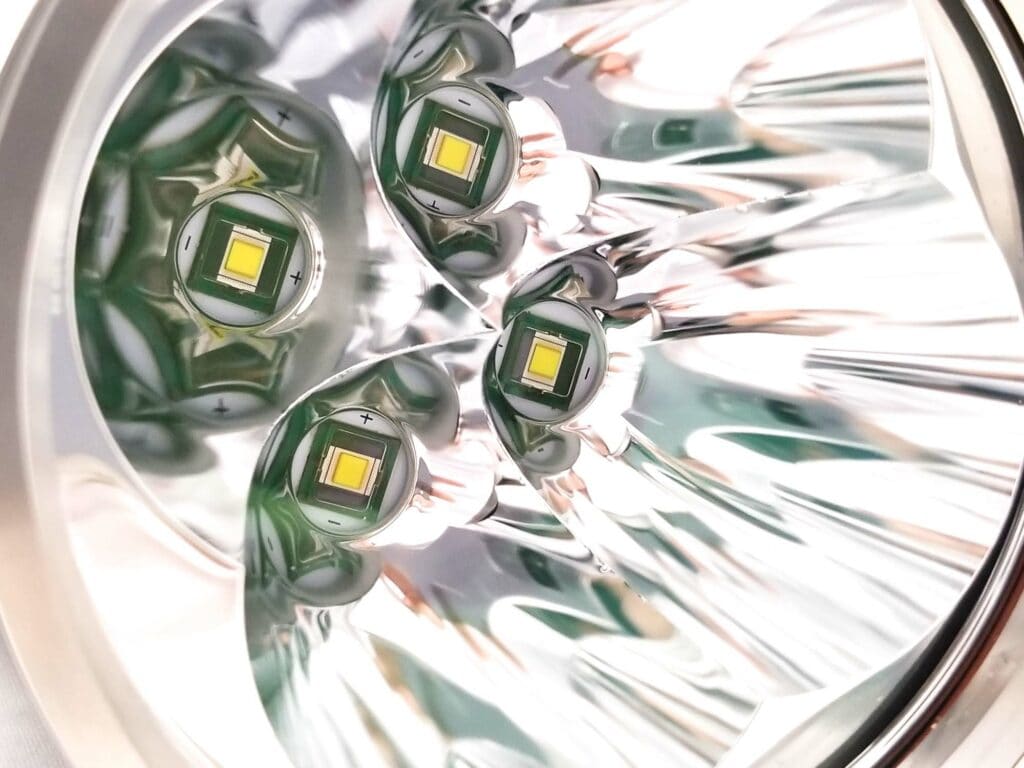

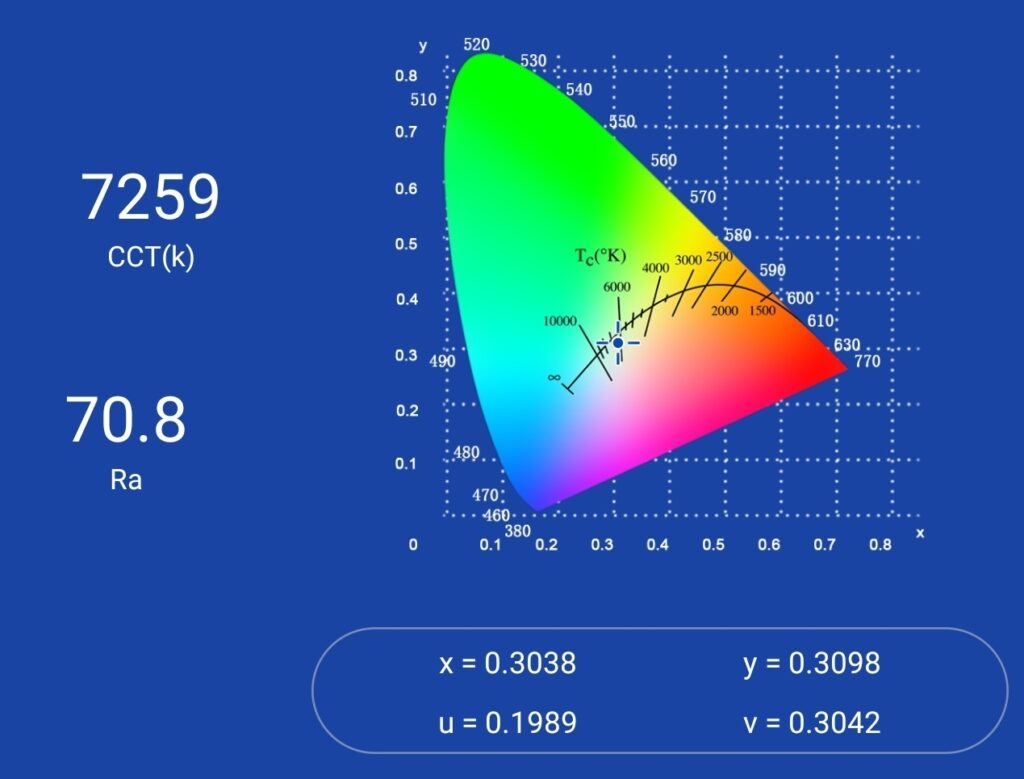
Dimensions and size comparison
Dimensions:
| Dimension | Millimeters | Inches |
|---|---|---|
| Length | 180 | 7.08 |
| Head diameter | 95 | 3.74 |
| Body diameter | 51.3 | 2.01 |
Weight:
| Weight | Grams | Oz. |
|---|---|---|
| Without battery: | 980 | 34.6 |
| With 3 Molicel P42A batteries | 1181 | 41.7 |
Flashlight size comparison with its competition
I compared the HT90 to some other high output flashlights and long-throw lights.
Group 1: Haikelite HT90, Fenix LR80R
Group 2: Haikielite HT90, ThruNite TN50, NightWatch NS59v1, Thorfire C8
Group 3: Haikelite HT90, WildTrail WT90
Group 4: Haikelite HT90, Haikelite HK90
Group 5: Haikelite HT90, Amutorch DM90
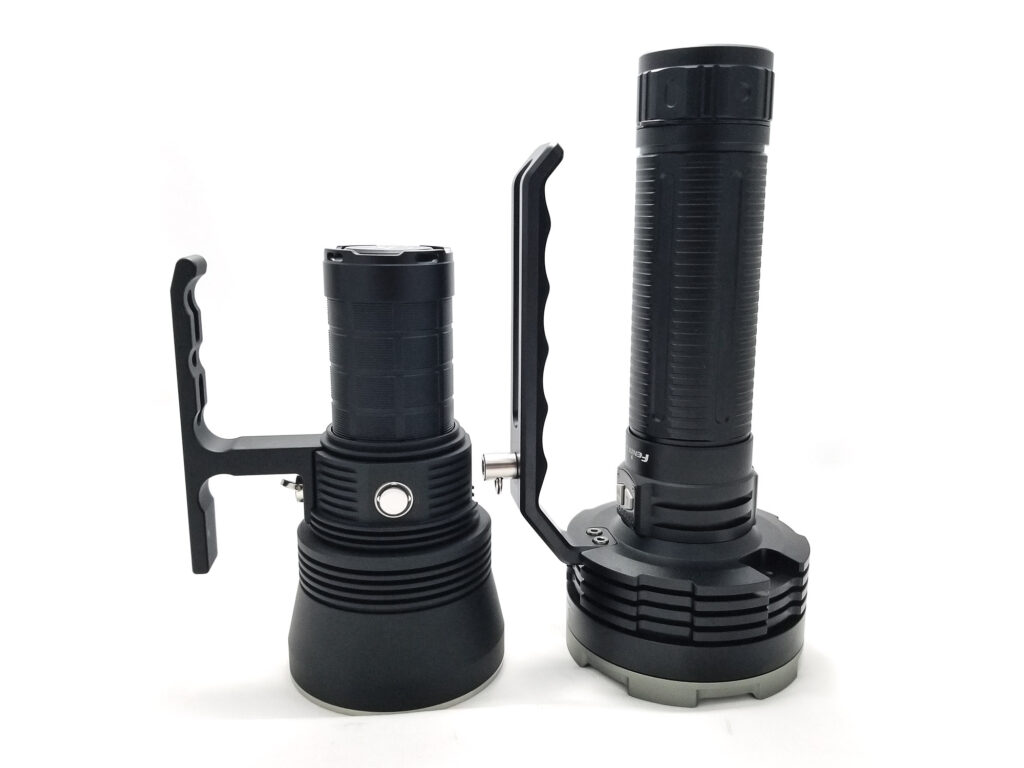
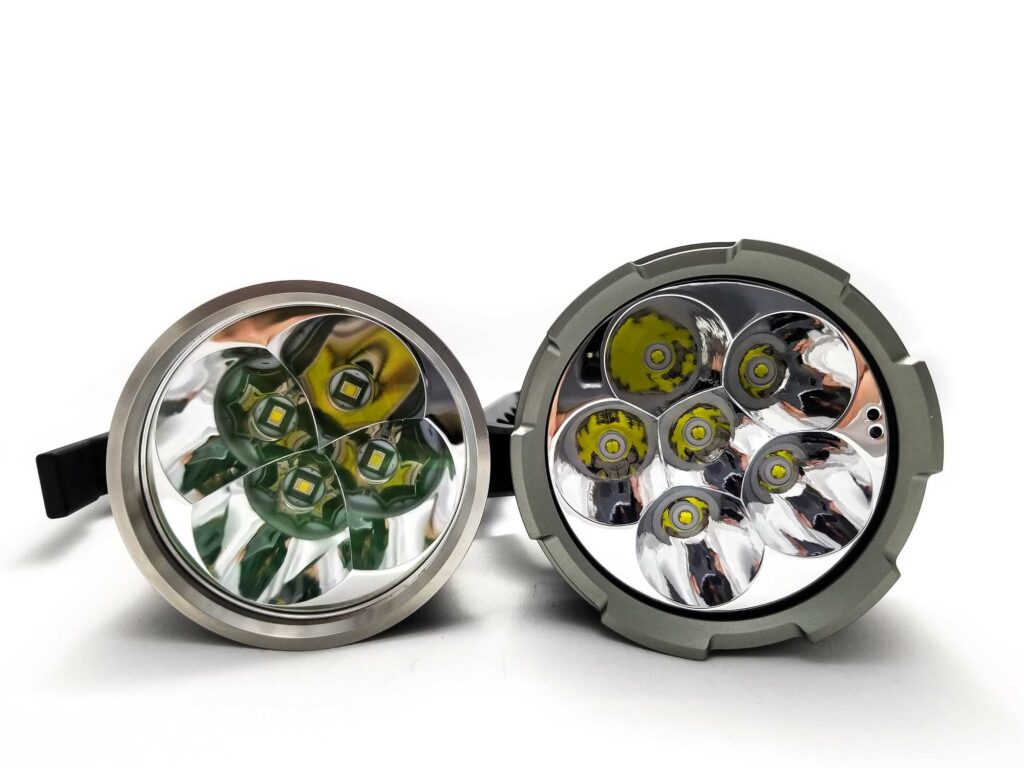
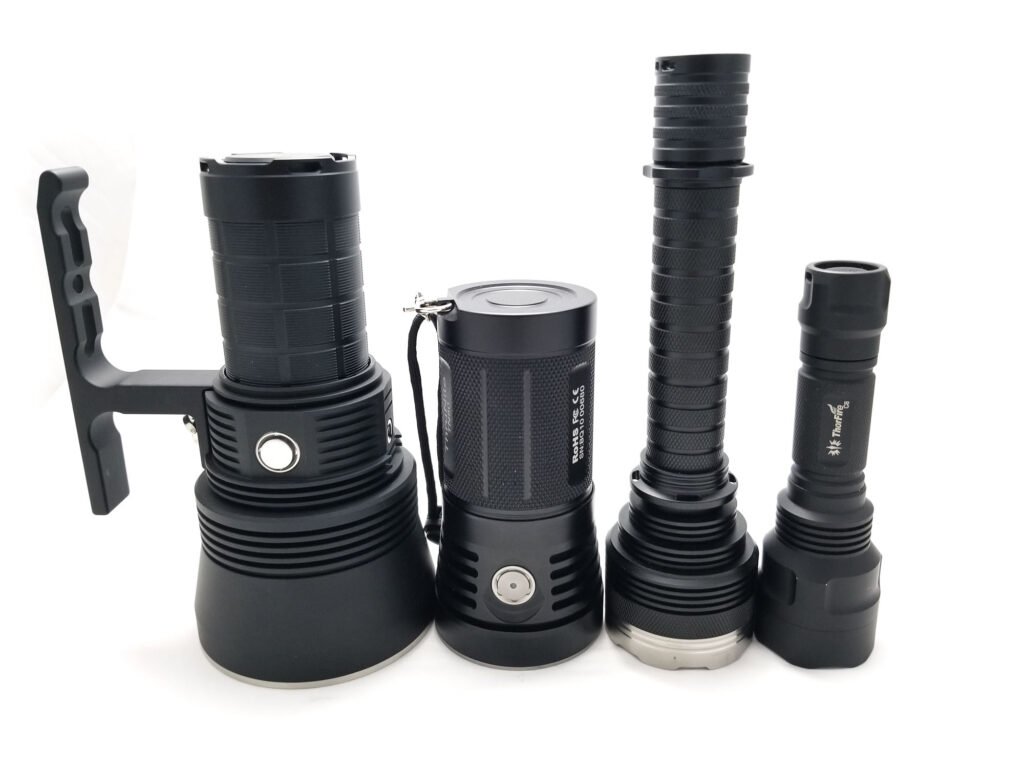
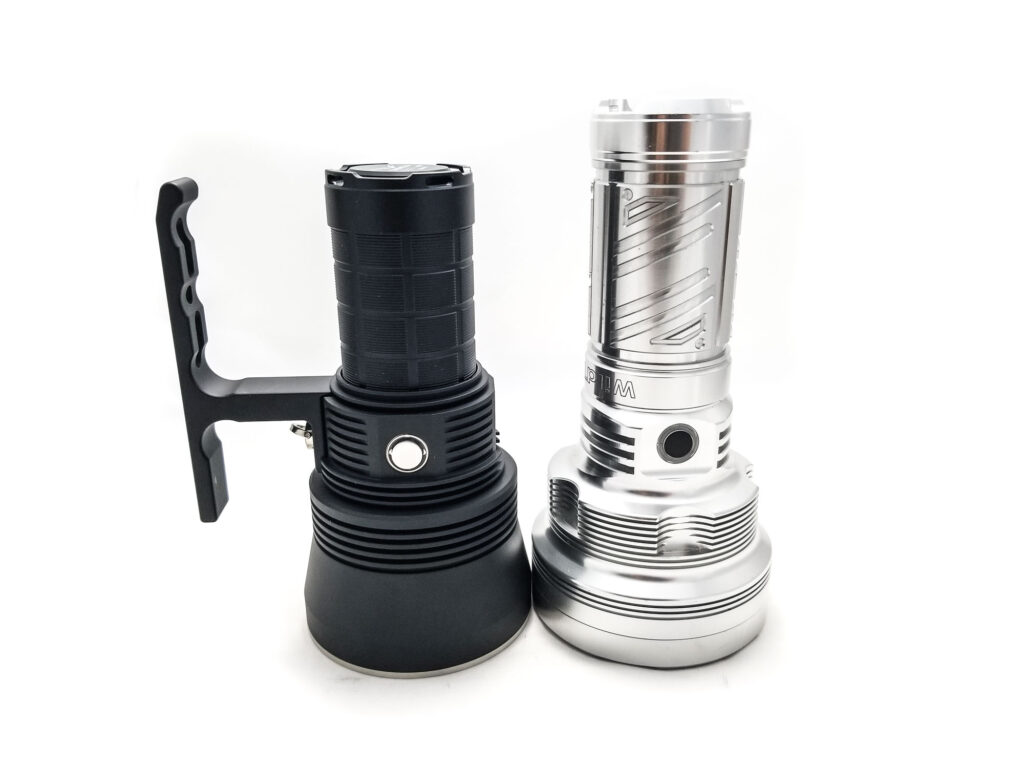
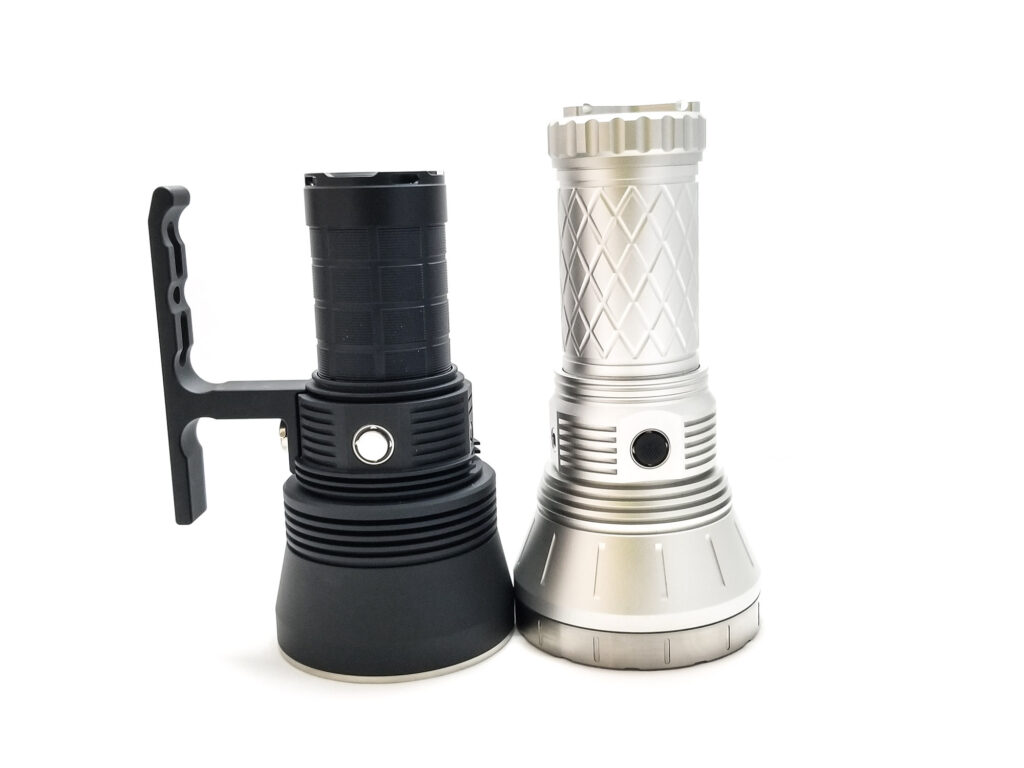
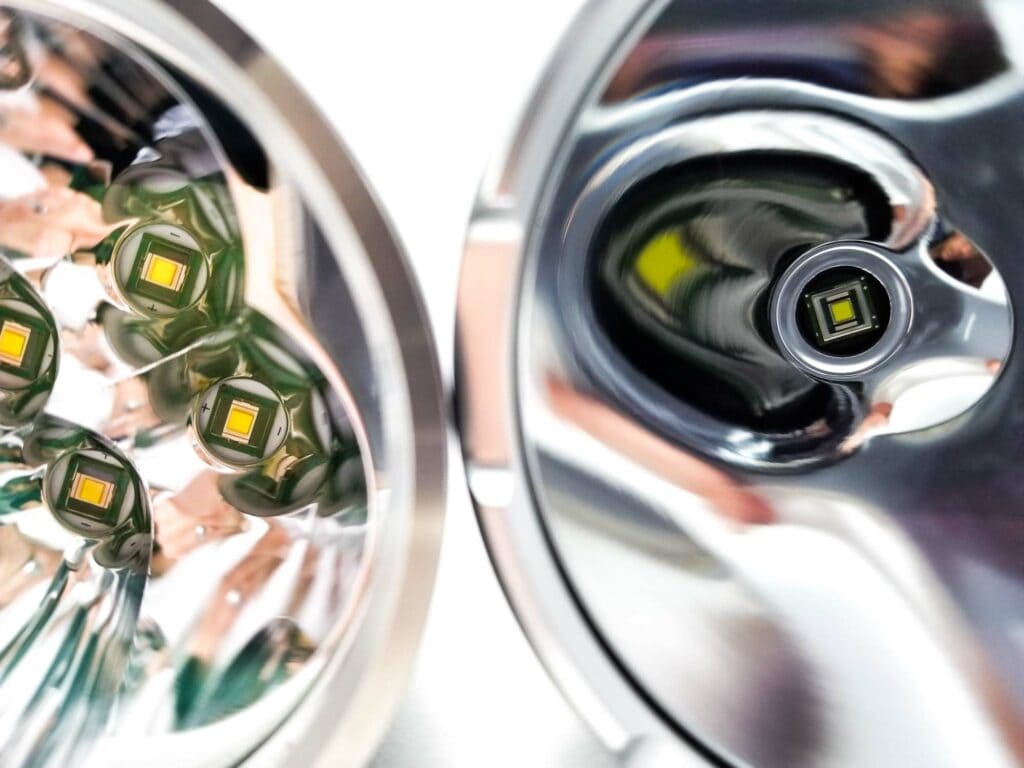
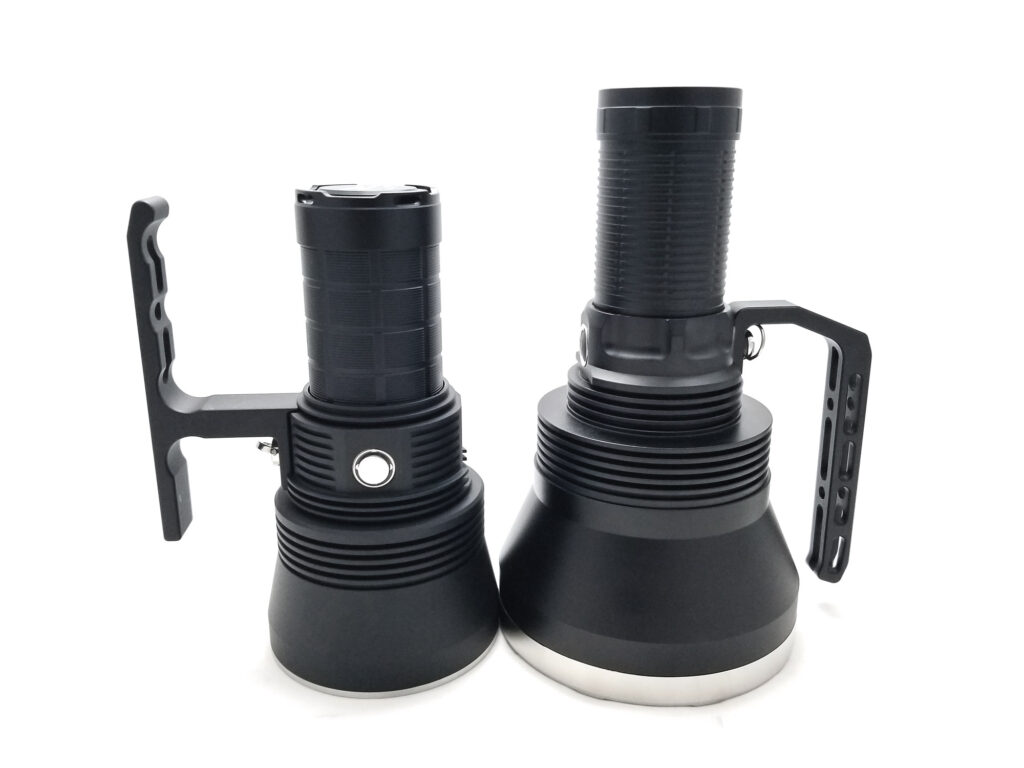
Driver & User Interface:
No mention is made of the driver, but I presume it’s going to be a linear FET driver. Since these are 3 volt LEDs and the battery carrier runs in parallel, there’s no need to boost the voltage. I can’t get it out to check, but the runtimes will give up its secrets in the event there’s a boost driver hiding in there (I doubt it).
The UI is a simple one click off, one click on, with 4 stepped modes, Turbo, and a few blinkies. Haikelite also adds a smooth ramping mode as well. Stay tuned for a nice surprise!
Available modes: Moon, Low, Medium, High, Turbo, or alternate smooth ramping
Available blinky modes: Strobe, SOS, Tactical Strobe
User interface:
From OFF:
- Press and Hold: Pressing and holding for 4 seconds activates electronic lockout
- Single click: Turns on in last mode
- Double click: Turbo
- 3 clicks: N/A
- 4 clicks: N/A
From ON:
- Press and Hold: Ramps up. To ramp down, release and press and hold. Press and hold also switches modes in stepped ramping mode
- Single click: Turns off
- Double click: Turbo
- 3 clicks: Switches between smooth and stepped ramping
Mode memory:
- Yes, last mode memory. Turbo and Strobes are not memorized
Shortcuts:
- Switch to smooth ramping: Triple click
- To Turbo: Double click
- To Strobe: When in Turbo, double click for Strobe, double click again for SOS, double click again for Tactical (fast) Strobe
Low voltage warning:
- The switch aux LEDs show battery state: Solid blue for 3.2 volts or more, solid red for 3.0 volts, and flashing red for 2.8 volts. Below 2.8 volts, LVP will trigger shut down.
Strobe/blinkies
- Strobe, SOS, Tactical Strobe (fast strobe). Strobes are accessed from Turbo mode, with each mode accessed with a double click.
Lock-out mode:
- Yes. Accessed from off by pressing and holding the switch for about 4 seconds. The light will blink once to acknowledge. Repeat to unlock.
PWM
- Yes, but fast PWM and not visible by eye.
Additional info on the UI:
- I really like this UI. It’s typical Haikelite. It’s simple to use and anyone could pick up the HT90 and master it easily. The mode spacing is acceptable, but the real treat here was the smooth ramping. I don’t usually have high hopes for non-Anduril smooth ramping UIs, but I was pleasantly surprised by the HT90s smooth ramping implementation. I liked the 3 clicks to switch between stepped and smooth ramp as well. The blinkies are a bit odd, stacked on top of Turbo, but at least they aren’t part of the regular UI mode set. You get electronic lockout (important in a high power light like this), and there’s not much fluff here either which I also like. Think of it as abbreviated Anduril. Haikelite says there’s intelligent thermal control built in as well, set for thermoregulation at 55 C.
Batteries & Charging
The Haikelite HT90, like the HK90, and HK29, uses three, 21700 lithium ion batteries for power. Haikelite recommends button top batteries and they are loaded directly into the tube. The batteries are arranged in parallel for the 3 volt G90 LEDs and this is great for capacity, since each battery’s capacity is shared across the three cells (3, 4000 mAh equates to 12 Ah). Although it’s less critical than in a series configuration, it’s optimal to use batteries of the same age, same brand, capacity, and discharge capacity. Mismatched batteries can significantly lower both output and battery life and runtime, and in some situations, cause damage to one or more batteries.
Like most modern lights, the HT90 features onboard USB type C charging, and it’s set up for QC2.0 and Huawei SCP5A charging, so 5V 3A, 9V 2A, 12V 1.5A, and 5V 4.5A. You’ll need an appropriate power supply or the Huawei charge protocol though, and Haikelite doesn’t include one. I plugged the HT90 into a PD power bank with a type C to type C cable and the light started charging at 12 volts 1.53 amps. On a QC charger my Ruideng AT35 USB tester showed 9 volts and 1.9 amps on mostly discharged batteries.
The power bank is good for bidirectional charging, up to 5 volts 4.5 amps maximum. I plugged the Nightwatch NG01 into the HT90 and it started charging at 4.95 volts 3.1 amps according to my USB tester. The HT90 charged a PD capable power bank at 12.1 volts and 1.54 amps. I don’t have a Huawei SC5A capable charger, so I can’t test that protocol.
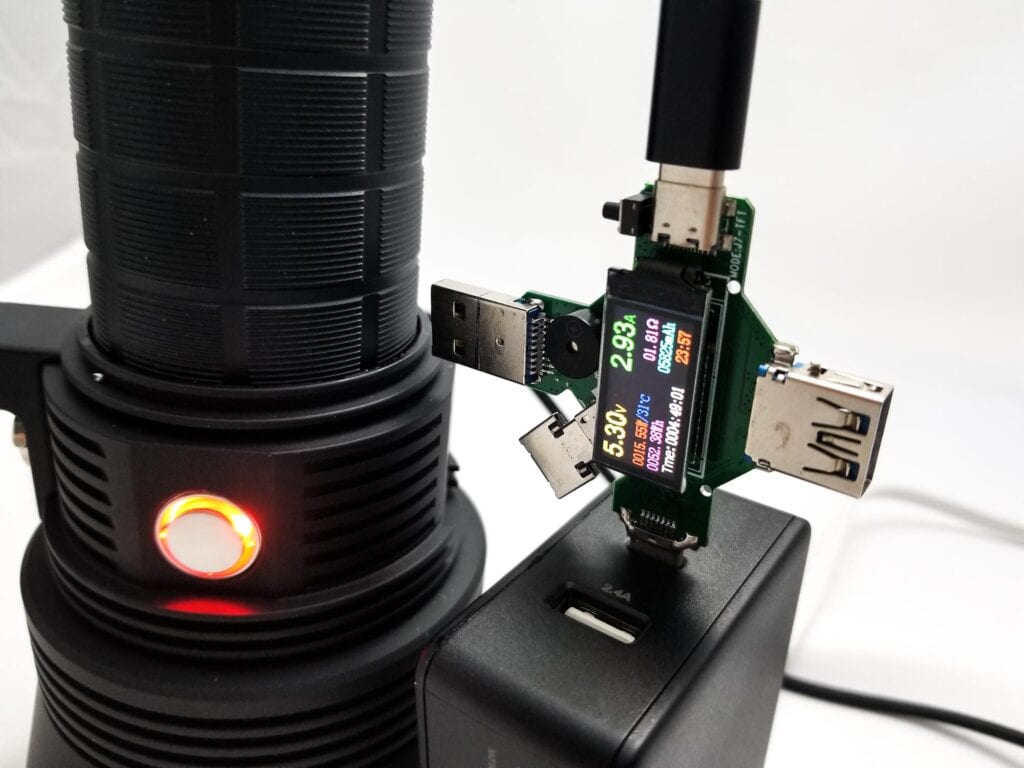
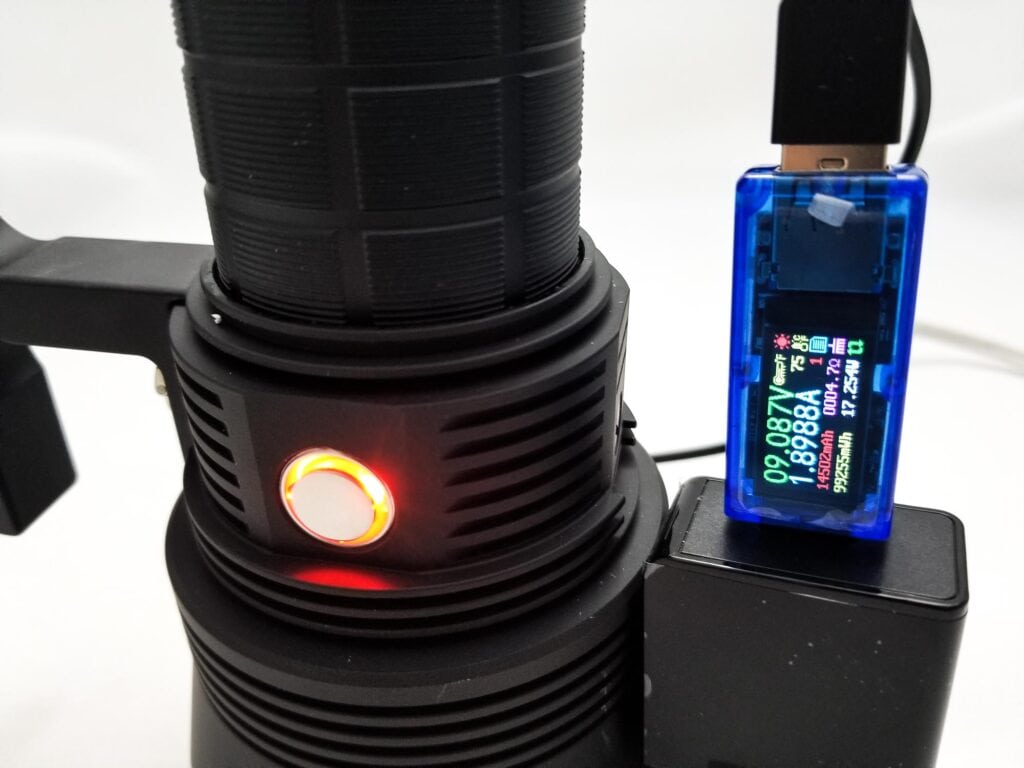
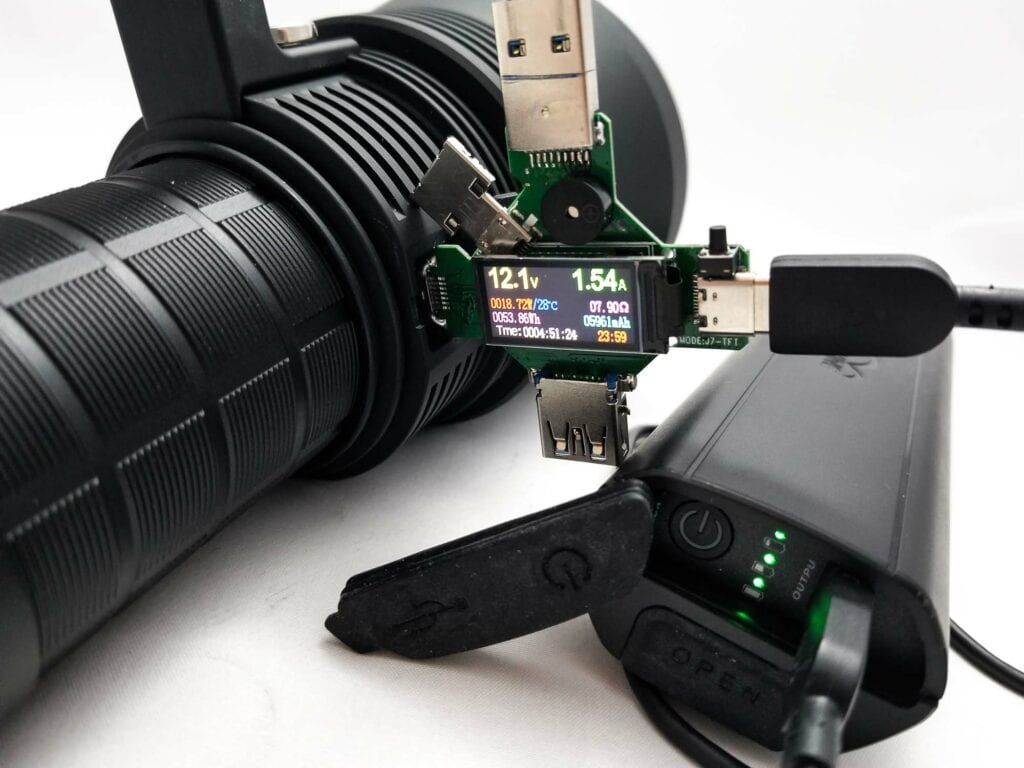
Performance test
Lumen measurements
Lumens are measured using my home made 50 cm integrating sphere, and I use a Digi-Sense 20250-00 datalogging luxmeter. The sphere has been calibrated using a Convoy S2+ calibrated to 260 Lumens, so these are within 10% of actual output. All measurements taken at 30 seconds using the included fully charged Molicel P42A 4200 mAh batteries. No amp measurements this time. You need to be a gymnast (and brave) to measure current with these lights!
| Mode | Specs | turn on | 30 sec | 10 minutes |
|---|---|---|---|---|
| Moon | 200 | 25.80 lm | 25.8 lm | – |
| Low | 1300 | 448 lm | 448 lm | – |
| Medium | 3500 | 1,522 lm | 1,496 lm | 1406 lm |
| High | 6000 | 4,180 lm | 4,012 lm | 1858 lm |
| Turbo | 20,000 | 10,965 lm | 9,804 lm | 1677 lm |
Parasitic drain:
- N/A
I’m a bit confused here. Moon is coming in quite a bit lower than Haikelite’s spec, and same with Low. The other numbers are way down as well.
Battery Life: Runtime graphs
Runtimes are measured using my home made 50 cm integrating sphere, and I use a Digi-Sense 20250-00 datalogging luxmeter. The sphere is calibrated using a Convoy S2+ calibrated to 260 Lumens. I used the included, fully charged, Molicel P42A 4200 mAh batteries.
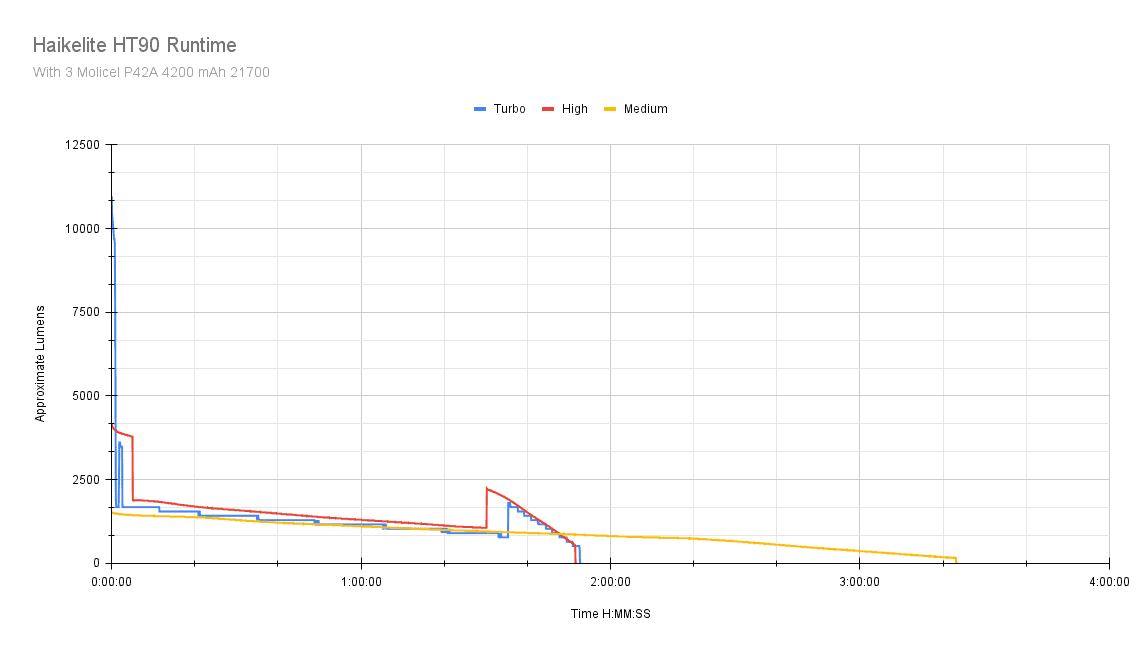

| Mode | Specified | Measured runtime (ANSI) | Time till shut off |
|---|---|---|---|
| Moon | ? | – | – |
| Low | ? | – | – |
| Medium | ? | 3h23m | 3h23m |
| High | ? | 1h51m | 1h51m |
| Turbo | ? | 1h06m | 1hr52m |
LVP works flawlessly and the batteries discharge to 2.84 volts after each test. The light was also usable after each test with abbreviated higher output modes and consistent lower output modes available. There’s an abrupt LVP cutoff as well. The graphs are a bit weird, with Turbo showing elevated output at the 1 minute 45 second mark, lasting about 50 seconds before stepping back down. Both High and Turbo both have a weird bump in output at about 1 hour 30 minutes in, then a gradual ramp down. Strange. The ATR is unintrusive and doesn’t take the output on a rollercoaster like the Nightwatch NG01 did, so that’s good. The highest temperature I observed for all the runtimes was 55 C for High and Turbo at 60 and 30 minutes (respectively). With the handle, it’s never too hot to handle.
ANSI FL1 standards: The runtime is measured until the light drops to 10% of its initial output (30 seconds after turning on). This does not mean that the flashlight is not usable anymore. The last column shows how long the light actually works till it shuts off. If there is a + symbol, it means that the test was stopped at that particular point, but the light was actually still running. This happens on certain occasions, with certain drivers, firmware, or batteries.
Peak beam intensity and beam distance measurements
Throw was measured outdoors at 10 meters using the Uni-T UT383S luxmeter. Measurements taken at 30 seconds.
| Mode | Specs | Candela measured | Meters | Yards |
|---|---|---|---|---|
| Moon | ? | 1000 | 63 | 69 |
| Low | ? | 19,100 | 276 | 302 |
| Medium | ? | 61,300 | 495 | 542 |
| High | ? | 163,900 | 810 | 885 |
| Turbo | 650,000 cd | 428,200 cd | 1,309 | 1431 |
Haikelite only lists a single throw figure of 650 Kcd and 1600 m throw (probably on Turbo). I’m coming in quite a bit less than Haikelite’s spec, but not surprising since the other output figures are down also. It makes me wonder if Haikelite used a 40 amp battery like a 30T for their output test, or measured from 5 meters. Compared to something like the 3 SBT90.2 Haikelite HK90, the throw isn’t as good, but it’s probably due to the smaller diameter head. Still, this is on par with a single LED thrower, but with 10 times the output.
Extra info: Peak beam distance according to ANSI FL1 standards: The calculated value of distance in meters at which the flashlight produces a light intensity of 0.25 lux. (0.25 lux is about the brightness of a full moon shining on an object).
Beamshots
I compared the HT90 to some other high output and long-throw flashlights. Photos taken with my Samsung Note 8. The 95 meter shots with the following camera settings 0.3s ISO 200 and 5000K WB. The 950 meter shots used 0.5s ISO 400 and 5000K WB.
Beamshots compared to the following flashlights (at 40 meters):
- Haikelite HT90
- Fenix LR80R
- Wuben A1
- Nightwatch NS59v1
Beamshots at 950 meters:
- Haikelite HT90
- Haikelite HK90
- Wuben A1
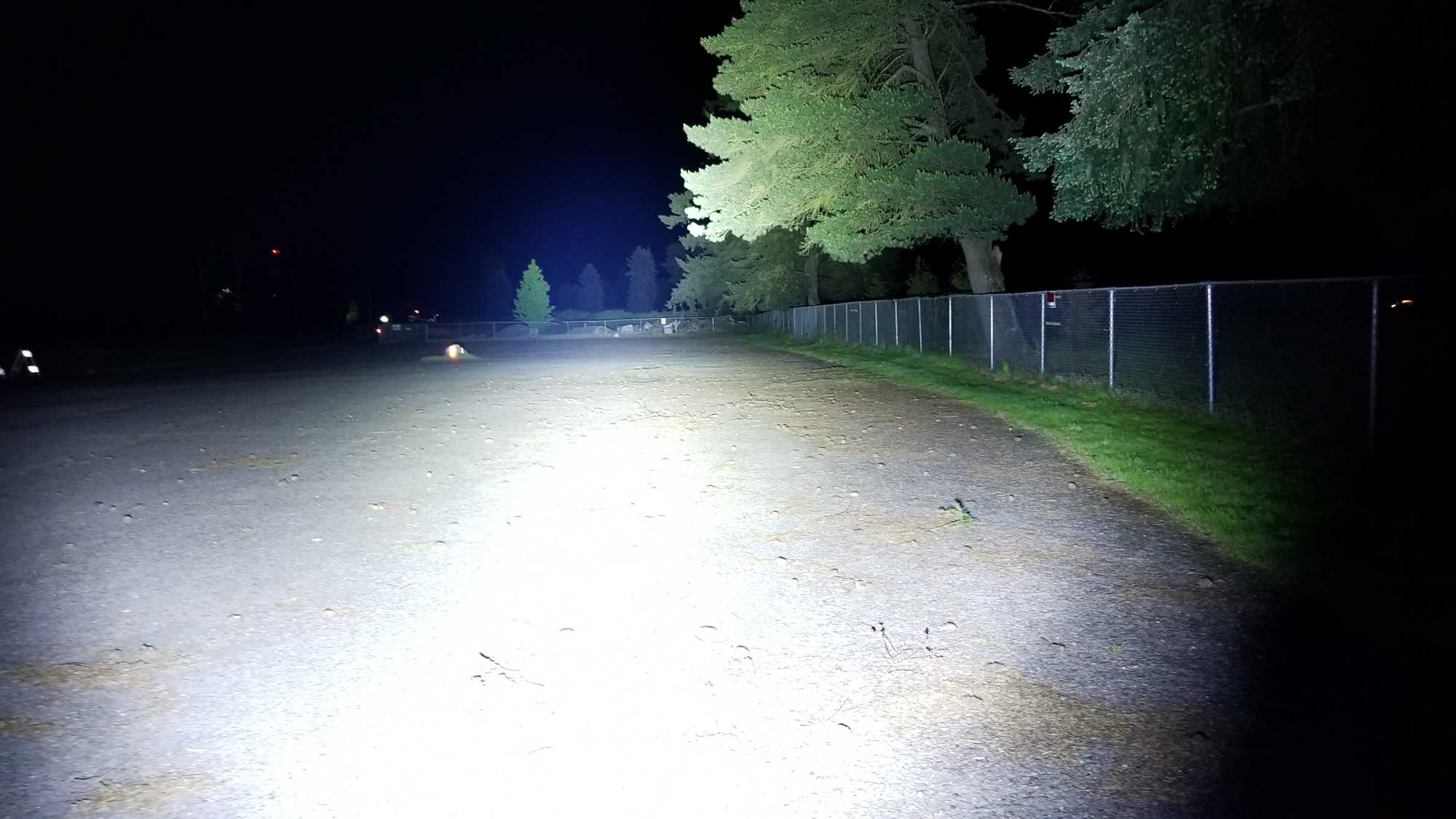
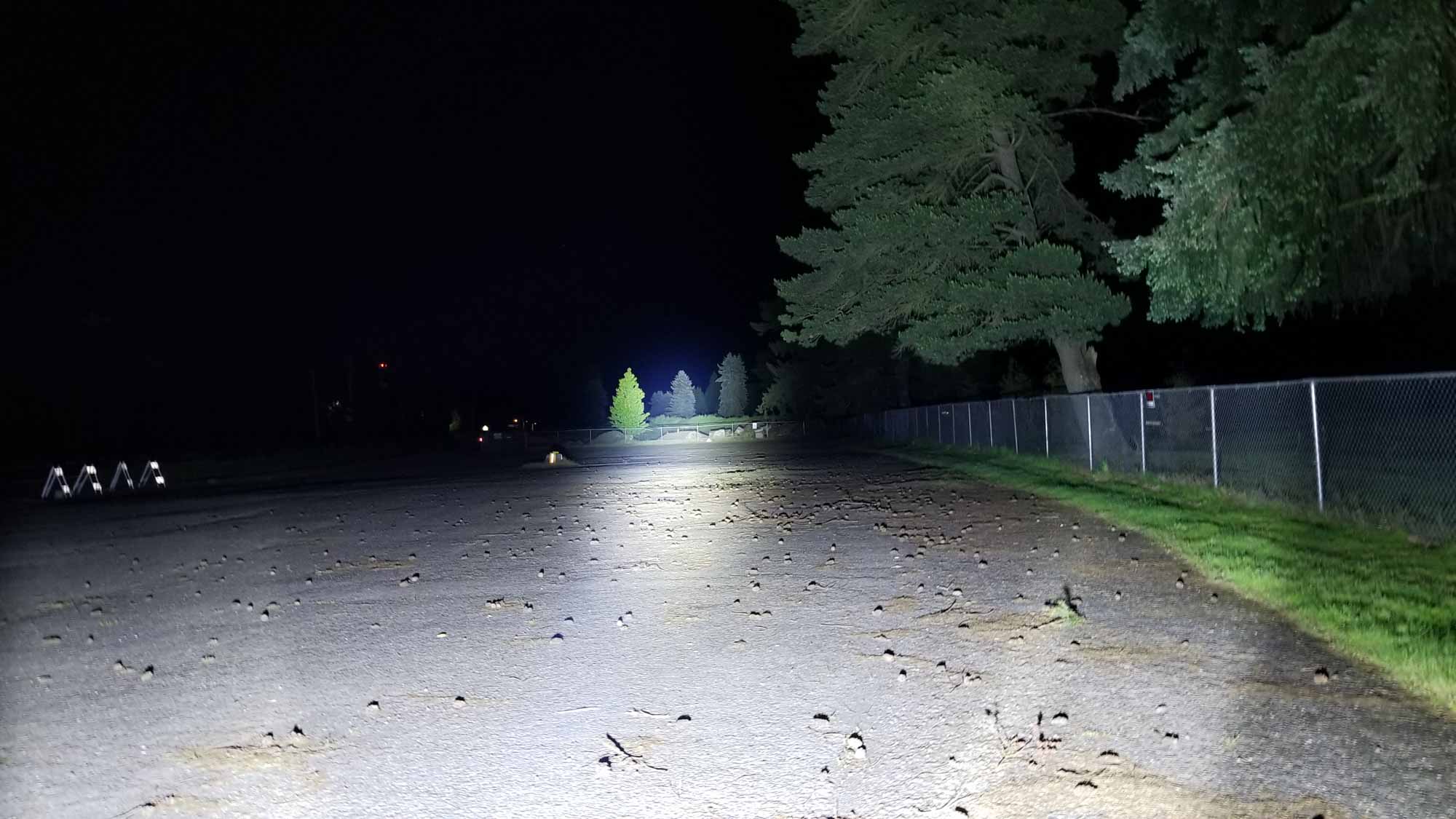

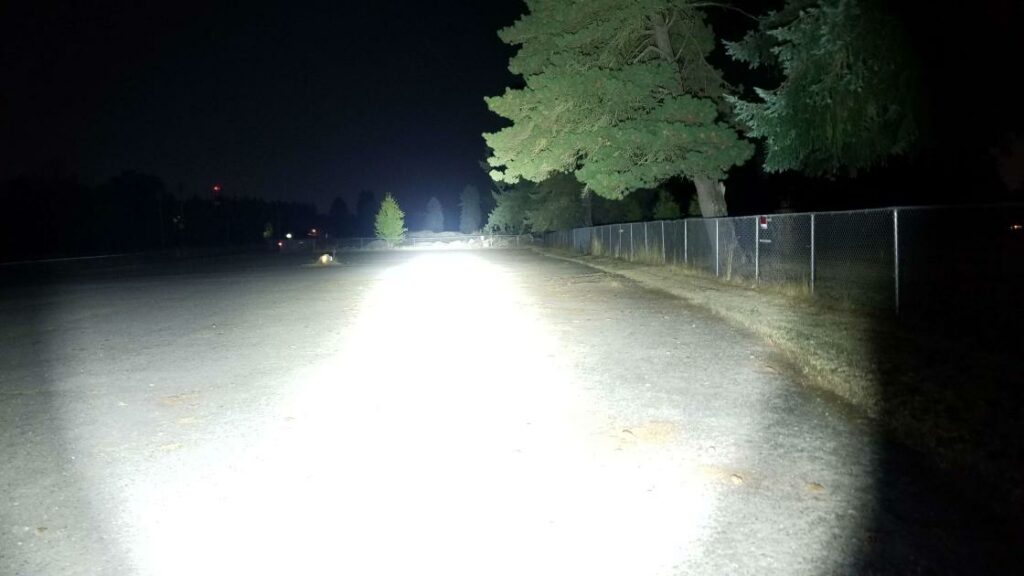
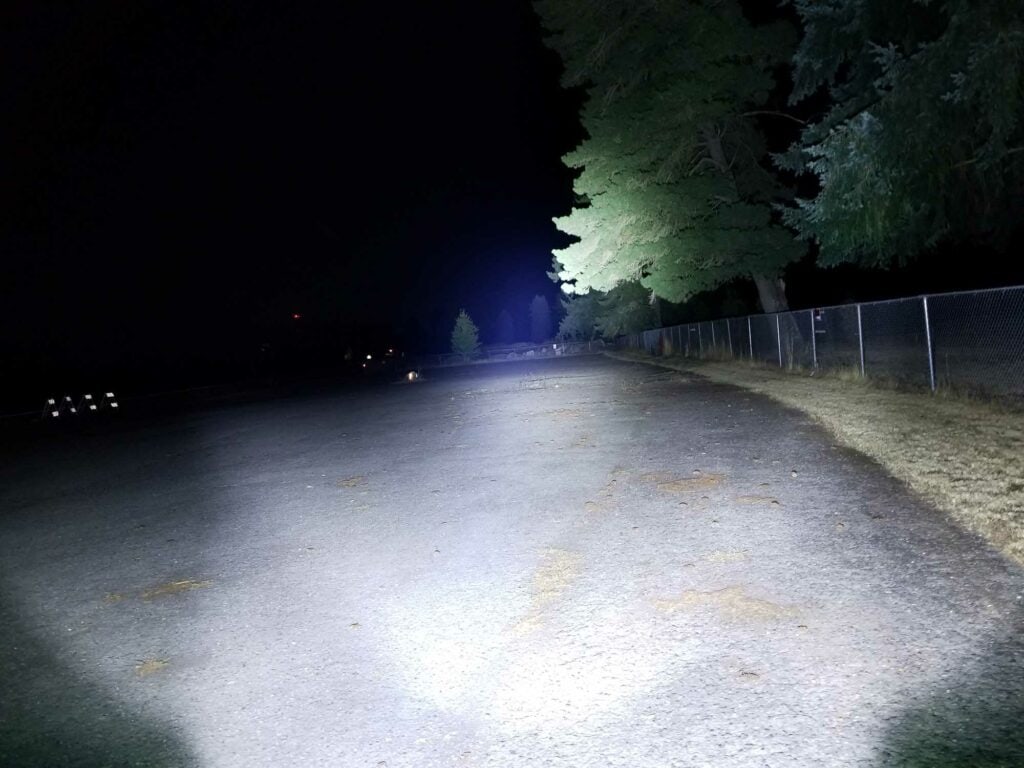
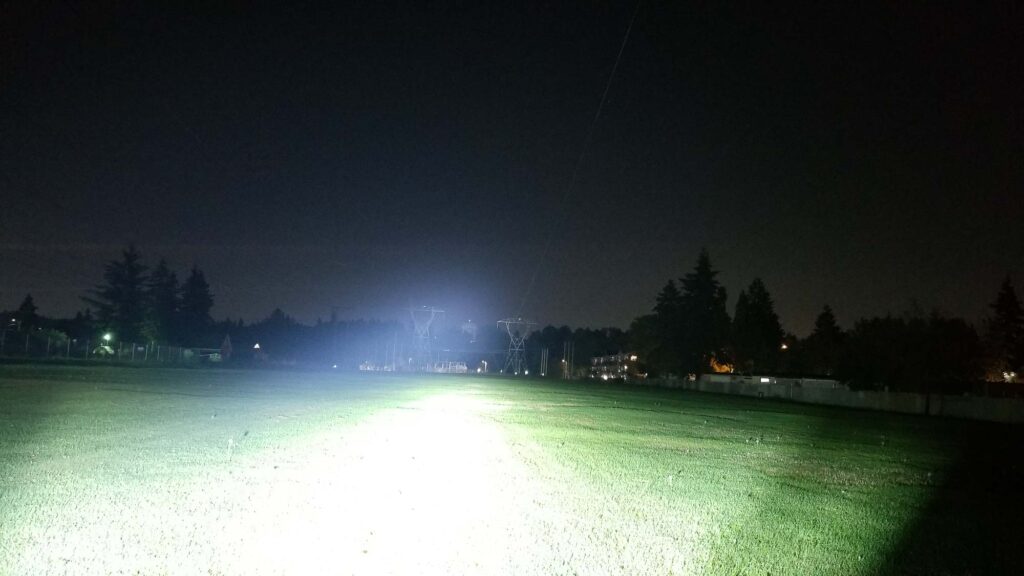
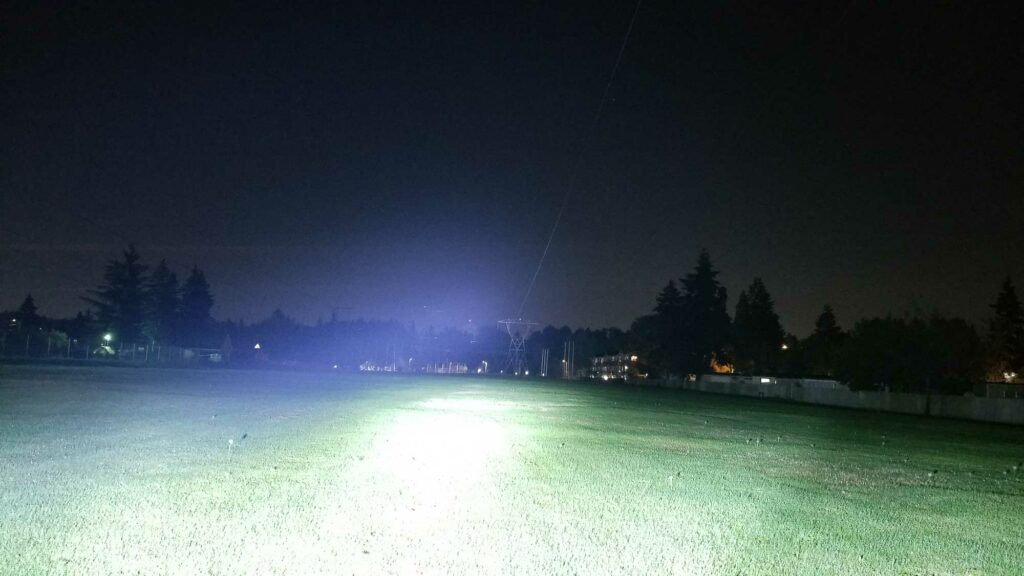
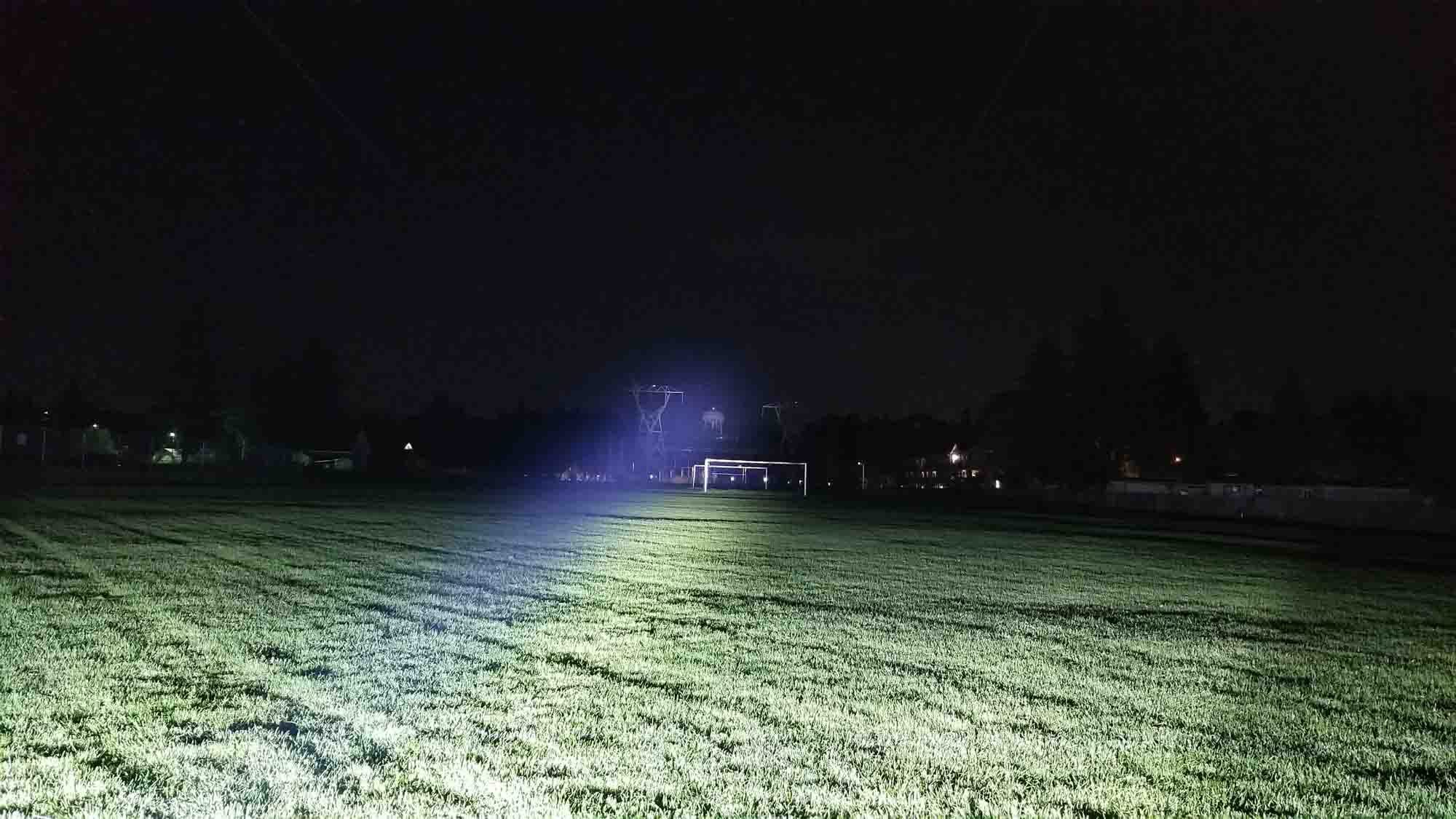
Disclaimer: This flashlight was sent to me for review at no cost by Nealsgadgets. I have not been paid to review, nor have I been holding back on problems or defects.
Final Verdict
Pros
- Decent build quality
- Somewhat compact form factor
- Quick charging and power bank
- Simple to use UI
- Great smooth ramping
- Pretty bright
Cons
- Didn’t meet specifications
- Needs button top batteries
- Runtimes aren’t impressive
Explanation on star ratings:
1: Avoid: a match would be a better choice – 2: Poor: significant defect or issues; almost unusable – 3: Average: some defects or issues; but still usable 4: Good: recommended (minor issues) – 5: Great: highly recommended

4 stars: ★★★★
In the realm of multi-LED, high output, long-throw flashlights, you’re either at the top (GT94X, Wuben A1), or not, and none of them are created equal, and once they start getting into the higher output side of things, the bar gets raised quite a bit (as does the price).
Haikelite has fielded more high output flashlights at reasonable prices than anyone else, so you’d think their newest release would be a hit. Well, the HT90, while it has amicable qualities, is just okay. Let me break it down. On the positive side, it’s well put together and seems to be good quality. Its also quite a bit smaller than the competition. The smooth ramping UI is one of the best I’ve encountered outside Anduril. It’s also a good value, coming in over $100 cheaper than the next closest competitor (which happens to be the Haikelite HK90).
I really liked the quick charging and the equally high output power bank (to take advantage of all those electrons). However, the rest…meh. It’s down about 50% of Haikelite’s specs for output, and the throw is about 30% off. I was expecting the numbers to be on the low side, but not this low. Maybe my sample is underperforming, or it needs some higher-output batteries? So where does the HT90 fit in the multi-LED, high output, long-throw ecosystem? Well, if you aren’t privy to Anduril, but like ramping UIs, and want a smaller form factor, long-throw quad LED light, for what it is, the HT90 is worth a look, and it’s not all bad. 4 stars for the HT90.
Buy Haikelite HT90 with our discount code
Coupon code: 1LumenNEW or 1lumen711 for 15-25% off
1lumen selects and reviews products personally. We may earn affiliate commissions through our links, which help support our testing.